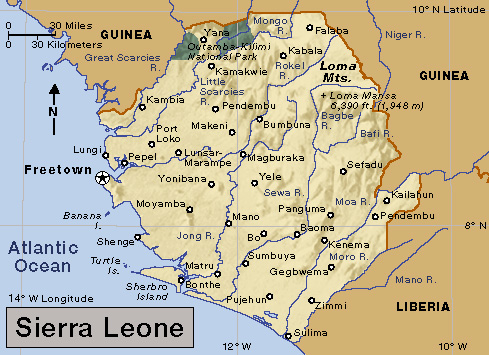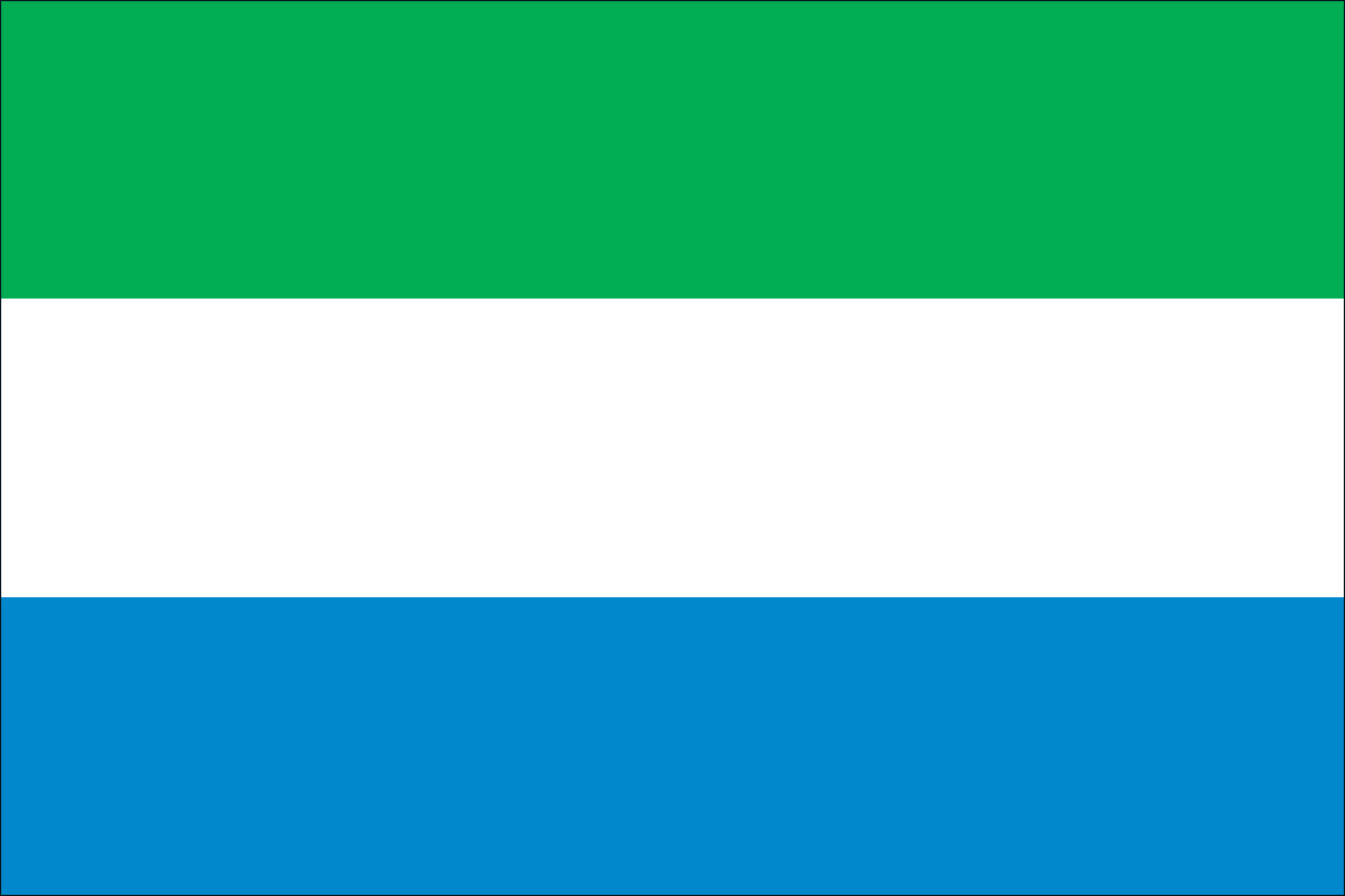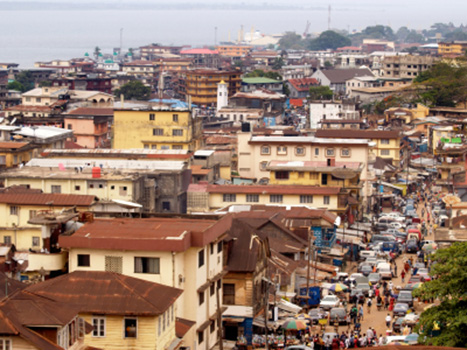Sierra Leone << see AIR uh lee OHN >> is a small country on Africa’s western “bulge,” north of the equator. Sierra Leone provides a large portion of one of the world’s most valuable treasures—diamonds. The diamonds lie in gravel deposits along riverbeds and in swamps in eastern parts of the country. Many diamonds are used to make gemstones, and the rest are less expensive diamonds used in industry.

Sierra Leone, a former British colonial possession, became independent in 1961. It remained a member of the Commonwealth of Nations. Freetown is the country’s capital, largest town, and main port. The city was founded in 1787 as a settlement for freed slaves.
Government.
According to Sierra Leone’s Constitution, the president is the head of state. The president is elected by the people to a five-year term. A cabinet, appointed by the president with the approval of Parliament, carries out the daily operations of government. Parliament also has lawmaking power. Parliament’s 146 members serve five-year terms.

People.
Most men of Sierra Leone are farmers. Many grow only enough food for their families and work during the dry season mining diamonds. The women often sell goods in local markets. Freetown has many modern buildings. Many people in villages live in concrete block houses. Many of the poor people in rural areas live in mud houses with corrugated iron or thatched roofs.
Sierra Leone’s people form nearly 20 ethnic groups. About a third of the people belong to the Mende group. They live in the southern part of the country. About a third of the people belong to the Temne ethnic group, who live in western Sierra Leone. A small percentage of the people are Krios, also called Creoles, who live in or near Freetown. They are descended from freed slaves. English is Sierra Leone’s official language. However, most of the people speak local African languages and Krio. Krio is derived from English and African languages.
Over half of the people are Muslims. Many others practice local religions. For example, the Mende believe Ngewo (God) created the world and everything in it. They place great value in nomoli, small humanlike figures carved in stone, which they find in the soil. They believe that possessing one will bring them an abundant yield of crops. No one knows for certain who carved the nomoli, but scholars believe they date from the 1400’s. Some people, such as the Krios, are Christians.
The law does not require the children of Sierra Leone to go to school. The University of Sierra Leone is in Freetown. About half of the country’s people 15 years old and older can read and write.
Land.
Freetown is at the end of the Sierra Leone Peninsula. The Sierra Leone mountains rise to about 3,000 feet (910 meters) above sea level there. Swamps cover most of the country’s coastal region and extend about 20 miles (32 kilometers) inland.

Inland from the swamps, a coastal plain extends as far as 100 miles (160 kilometers) in the northern part of the country. This plain slopes up to a region of plateaus and mountains in the northeast that covers about half of the country. The mountains rise to more than 6,000 feet (1,800 meters) near the eastern border with Guinea. Loma Mansa, 6,390 feet (1,948 meters), is the country’s highest point. Gravel or sandy soil, on which only short grass grows, covers more than half the country.
Sierra Leone has a rainy, tropical climate. The dry season lasts through January and February in the south, and from December through March in the north. Freetown receives about 144 inches (366 centimeters) of rainfall a year. Only a narrow strip in the north has less than 80 inches (200 centimeters) a year. Temperatures average from 77 to 81 °F (25 to 27 °C) except in the extreme north, where a greater variation of temperature occurs.
Economy.
Sierra Leone is a poor country. Many of the country’s people live in poverty. Agriculture accounts for about half of Sierra Leone’s total economic output. About two-thirds of the country’s workers are farmers. But poor soil, the dry season, and the use of traditional farming methods keep yields low.
Rice is the main food crop. Farmers also grow citrus fruit, peanuts, tomatoes, and cassava (a plant with roots similar to potatoes). For export, they raise coffee; cacao (seeds used to make chocolate); kola nuts, which are used to make soft drinks; and palm kernels (palm seeds that contain a valuable oil). Sierra Leone also exports piassava, a fiber from the raffia palm used in making brushes. Farmers raise beef and dairy cattle and chickens. People catch large amounts of shad and other fish along the coast.
Diamonds make up much of the total value of Sierra Leone’s exports. The government tries to control the quantities of diamonds mined, but many people mine diamonds illegally and smuggle them out of the country. Sierra Leone also mines bauxite and rutile. Bauxite is used in making aluminum, and rutile contains the important metal titanium. Bauxite and rutile are important export products.
Manufacturing plays a small role in Sierra Leone’s economy. The country manufactures beverages, cement, footwear, and textiles.
Sierra Leone has no railroads. Most roads are unpaved, but they are fairly well maintained. Few people own a car. Buses and taxis operate in the cities. About 500 miles (800 kilometers) of rivers are navigable by small craft. Freetown has the country’s main port. Lungi, near Freetown, has an international airport.
History.
People have lived in what is now Sierra Leone for thousands of years. The Portuguese began visiting the area after 1462. In the 1500’s, other European trading ships began stopping there. The Europeans shipped many people from this area to the Americas as slaves. About 1725, Fulani people who lived north and east of present-day Sierra Leone began a holy war to convert their neighbors to Islam. As the Fulani moved westward, many other peoples also migrated toward the coast and settled in what is now Sierra Leone.
In 1787, Granville Sharp, an Englishman opposed to slavery, settled about 400 formerly enslaved Black Americans on land where Freetown now stands (see Sharp, Granville). The settlers suffered from hunger, disease, and warfare, and the settlement almost died out. The United Kingdom made the slave trade illegal in 1807. The next year, the British government made the Sierra Leone Peninsula a colony. The British freed people from the slave ships of many nations and settled them in the colony. British influence gradually spread inland. In 1896, the British established a protectorate over an area that, with the colony, had almost the same borders as present-day Sierra Leone.
Between 1896 and 1961, Sierra Leone moved gradually toward self-government. In 1961, it became completely independent. Sir Milton Margai became the first prime minister. Political leaders struggled for power after indecisive parliamentary elections in 1967. Army officers then took over the government. In 1968, the military government was overthrown. Siaka Stevens became head of a new civilian government. A new constitution adopted in 1978 made the All-People’s Congress the only legal political party. Stevens remained head of the government until 1985. Major General Joseph Momoh, commander of the armed forces, succeeded him.
In 1991, Sierra Leone adopted a constitution that legalized opposition political parties. Multiparty elections were planned for 1992. But in April 1992, soldiers led by Captain Valentine Strasser overthrew Momoh, took control of the government, and canceled the elections.
Also in 1991, Corporal Foday Sankoh led an uprising against Momoh. After Momoh was overthrown by Strasser, Sankoh’s forces, known as the Revolutionary United Front (RUF), began fighting the new government. A major cause of the fighting was each side’s desire to control the country’s vast diamond resources.
In early 1996, Sierra Leone held multiparty elections for president and Parliament. Ahmad Tejan Kabbah was elected president. In 1997, a rebel group supported by the RUF ousted Kabbah and took over the government. In 1998, West African troops known as ECOMOG returned Kabbah to power. In 1999, Kabbah and Sankoh signed a peace agreement that gave Sankoh and other RUF members positions in the Sierra Leone government. In early 2000, United Nations (UN) peacekeeping forces replaced the ECOMOG troops. In May, RUF rebels seized about 500 UN peacekeepers and held them hostage for several weeks. Sankoh went into hiding, but was soon captured. The hostage crisis resulted in more fighting between the RUF and the government.
Between 1991 and 2001, about 50,000 people were killed in Sierra Leone’s civil war. Hundreds of thousands of people were forced from their homes, and many became refugees in Guinea and Liberia. In 2001, UN forces moved into rebel-held areas and began to disarm rebel soldiers. By January 2002, the war was declared over. In May, Kabbah was reelected president. By 2004, the disarmament process was complete. Also in 2004, a UN-backed war crimes court began holding trials of senior leaders from both sides of the war. In December 2005, UN peacekeeping forces pulled out of Sierra Leone.
In August 2007, Sierra Leone held presidential and parliamentary elections. However, no presidential candidate won a majority of votes. A runoff election was held in September, and Ernest Bai Koroma was elected president. In early 2009, a UN-backed international court convicted three senior RUF leaders of war crimes and crimes against humanity. Koroma was reelected in 2012. In April 2018, Julius Maada Bio became president. He was reelected in 2023. 
In 2017, heavy rains struck Freetown and the surrounding area. In August, a devastating mudslide caused by the rains killed more than 1,000 people and left about 3,000 homeless and about 800 missing.
See also Amistad Rebellion; Cuffe, Paul; Freetown; Sharp, Granville.
